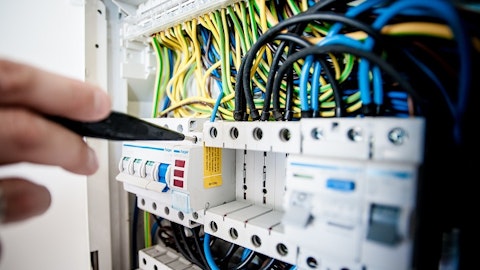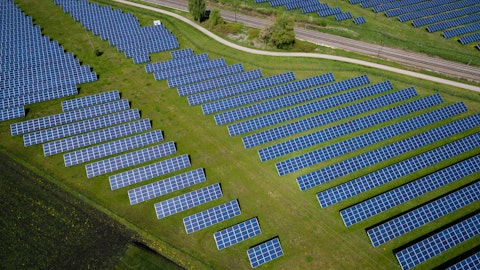Eaton Corporation plc (NYSE:ETN) Q3 2023 Earnings Call Transcript October 31, 2023
Eaton Corporation plc misses on earnings expectations. Reported EPS is $2.22 EPS, expectations were $2.34.
Operator: [Abrupt Start] Conference Call. [Operator Instructions] And as a reminder, today’s conference is being recorded. I would now like to turn the conference over to your host, Yan Jin, Senior Vice President of Investor Relations. Please go ahead.
Yan Jin: Good morning. Thank you all for joining us for Eaton’s third quarter 2023 earnings call. With me today are Craig Arnold, our Chairman and CEO; and Tom Okray, Executive Vice President and Chief Financial Officer. Our agenda today includes the opening remarks by Craig, then he will turn it over to Tom, who will highlight the company’s performance in the third quarter. As we have done in our past calls, we will be taking questions at the end of Craig’s closing commentary. The press release and the presentation we’ll go through today have been posted on our website. This presentation, including adjusted earnings per share, adjusted free cash flow and other non-GAAP measures that are reconciled in the appendix. A webcast of this call is accessible on our website and will be available for replay.

An overhead view of a powerful electricity transmission tower with in motion cables.
I would like to remind you that our commentary today will be including statements related to the expected future results of the company and are therefore forward-looking statements. Our actual results may differ materially from our forecasted projection due to a wide range of risks and uncertainties that are described in our earnings release and the presentation. With that, I will turn it over to Craig.
Craig Arnold: Okay. Thanks, Yan. We are pleased to report our Q3 results in another record quarter. Our team continued to deliver on our commitments, supported by strong markets and good execution. So, let me begin with some of the highlights on Page 3. As we have shared for some time now, megatrends, including reindustrialization, energy transition, electrification and digitalization are continuing to expand our markets, revenues, orders and negotiations pipeline as these trends are once again evident in our results in the quarter, especially in our Electrical Americas business. We posted another quarter of record financial results with strong revenue, margins, earnings and cash flow growth. While our markets continue to be strong, we’re also continuing to improve on our overall effectiveness, which drove our record operating margins, and we’re once again raising our earnings outlook.
We’re raising our ‘23 guidance for margins, adjusted EPS and cash flow. Our EPS growth for 2023 at the midpoint of our guidance is now 19%. I’d also like to highlight our growing backlog, which was up 15% in Electrical and 22% in Aerospace. And we continue to have a strong book-to-bill ratio of 1.1 for Electrical and 1.2 for Aerospace. Lastly, we recorded record third quarter operating cash flow of $1.1 billion, up 18% and free cash flow margins of 16%. Tom will share additional details. But overall, as you can tell, we’re pleased with the results and well positioned to close out a record year. Moving to Slide 4. In the last quarter, we shared a framework for how we think about our key market drivers for the company. The chart notes six megatrends that are driving growth capital investments and how they intersect with various businesses within Eaton.
As you can see, we’re uniquely positioned in most of our businesses and expect to see accelerated growth opportunities. It’s our intention to cover each of these markets and megatrends during our earnings call and to keep you appraised of progress. In our Q2 earnings call, we provided a summary of progress on infrastructure spending, reindustrialization and the utility market in Electrical and our Aerospace business. Today, we’ll spend a few minutes on how reindustrialization continues to drive a record number of mega projects in North America and how Eaton is positioned to win in the fast-growing data center market. We received an extensive number of questions on each of these topics and hope our updates are helpful as you think about the growth outlook for the company.
So let’s begin with Slide 5 in the presentation. We’ve shared this chart previously, and the data is a good proxy for reindustrialization and what we’re seeing inside of many of our markets. You’ll recall this chart summarizes the number of mega projects that have been announced since January of 2021, and a mega project is a project with an announced value of $1 billion or more. Note that this is the North America data, but we’re seeing a similar trend in Europe, although the dollar amounts are not as large. Three key points to note here. One, at $860 billion, this number is 3x the normal rate, which translates directly to future opportunities for electrical markets. As a reminder, the electrical content on these projects range from 3% to 5%.
Two, this number continues to grow at a faster rate. Announced mega projects grew between 25 – grew 25% between Q3 and Q2, and Q2 was up 20% from Q1. This will not go on forever, but there continues to be strong momentum for industrial projects in North America. And third, only 20% of these projects have actually started. For those that have started, we’ve won roughly $850 million of orders with a win rate of approximately 40%. And we’re actively negotiating another $1 billion of electric content on a small subset of these announced mega projects. Turning to Slide 6. We highlight the data center market. I can’t think of many markets that have better secular growth dynamics than data centers. The world’s appetite for data, new insights and software solutions continues to grow at an exponential rate.
And natural language processing, like ChatGPT, will only accelerate this trend. This is a very good thing for Eaton as we have a strong portfolio of data center solutions and the data center/IT channel represents 15% of our total revenue. While the numbers continue to be refined, we now think this market grows at a 16% compounded rate between 2022 and 2025 and likely for much longer. As expected, our customers are continuing to expand their data center CapEx build-outs, some of which are being modified to support the adoption of generative AI. Just consider some of these metrics. 120 zettabytes of data have been generated in 2023, a 60-fold increase over the 2 zettabytes generated in 2010. And the amount of data generated is expected to grow to 180 zettabytes by 2025, a 50% increase over 2023.
And the AI impact is just starting to show up in our order book. During Q3, we won a large order of approximately $150 million for a new AI training data center and saw a roughly 61% increase in hyperscale orders overall. These AI data centers require both high-power and high-power density and as a result, higher electrical content. Another trend driving higher electric content is the need for solutions that allow bidirectional flow of power back to the grid and the ability to optimize the use of renewable energy to power data centers. So this market and Eaton are well positioned for higher growth for years to come. And on Page 7, we highlight Eaton’s unique positioning in the data center market and note that we have the electrical industry’s broadest portfolio of power manager solutions for data centers.
Centralized data centers come in a variety of sizes with incoming power draws between 10 and 500 megawatts with the average data center of 40 to 50 megawatts, which is the variety that we show here on this slide. Eaton, we, support the flow of electrons from where they enter the facility from our transformers to our medium-voltage and low-voltage switchgear through our electrical busway to our uninterruptible power systems all the way into the server rooms, where we offer racks and power distribution units. In addition, we have a broad suite of software and service solutions that provide real-time diagnostics, prognostics and uptime support. As a rule of thumb, Eaton’s market opportunity in data centers is about $1.5 million per megawatt.
Here, we’re distinguishing this market from the myriad of smaller data centers that exist to support many different markets and smaller applications. And we continue to improve our position in the market with our Brightlayer for data center suite of software solutions. This platform is the first in the industry to unite asset management, IT and operational device monitoring, power quality metrics and advanced electrical supervision into one single application. This new software provides electrical power, power quality, distributed IT equipment performance management that improves efficiency, data accuracy and certainly uptime. So overall, Eaton is well positioned and continues to build on our strength in this rapidly growing market. Given our broad set of megatrends and our growth outlook, we’re naturally investing to add capacity in many of our businesses, as noted on Slide 8.
In fact, on the normal run rate, we’re investing more than $1 billion of capital to support the growth that we see over the next 5 years. These investments expand our production capacity across a wide range of markets and position Eaton to win more than our fair share of these opportunities. As you have heard, while somewhat improved, our lead times are still longer than ideal. And these investments will address the bottlenecks in our manufacturing sites. The primary investments are being made in utility markets to support transformers, both the regulators and our line insulation and production equipment and circuit breaker capacity to support the rapid growth in industrial projects and to add redundancy to our existing capability and in our global Electrical business to support growth in a number of fast-growing emerging markets, where we’ve been gaining share but have ample opportunities to do significantly more.
And of course, we’re building a completely new eMobility business and making significant investments to build out new manufacturing capacity there. These capital investments support higher organic growth, provide excellent return on investment and are indicative of our confidence in the future of the company. We’ve made some of these capital investments this year, while others will be layered in over the next couple of years. Now I’ll turn it over to Tom to cover our financial results and outlook for the year.
Tom Okray: Thanks, Craig. I’ll start by providing a summary of our Q3 results, which include several records. With respect to the top line, we posted an all-time quarterly sales record of $5.9 billion. Organic growth continues to be strong, up 9% for the quarter, building upon 6 consecutive quarters of double-digit growth and 3 quarters on a 2-year stack of mid-20s growth. Operating profit recorded all-time records on both a margin and absolute basis. Operating profit grew 23%, and segment margin expanded 240 basis points to 23.6%. We posted a very strong incremental margin of 46%, up sequentially from 33% in Q2 and 27% in Q1. Adjusted EPS increased by 22% over the prior year to $2.47 per share, an all-time quarterly record and well above the high end of our guidance range.
This performance resulted in a third quarter operating cash flow record. Our $1.14 billion in operating cash flow was 18% higher than the prior year, generating 16% free cash flow margin and over 100% free cash flow conversion. Looking at our results on a year-to-date basis. Organic growth is up 12%. Segment margin is up 170 basis points. We generated incremental margin of 35%, adjusted EPS growth of 19%, a 73% increase in operating cash flow versus prior year and free cash flow up 90% year-over-year. Moving on to the next slide. Our Electrical Americas business continues to execute well and delivered another very strong quarter. We set all-time quarterly records for sales, operating profit and margins. Organic sales growth remained very strong at 19%.
Electrical Americas has generated double-digit organic growth for 7 consecutive quarters with 6 of the quarters greater than 15%. On a 2-year stack, organic growth is up 37%. In the quarter, there was broad-based growth in nearly all end markets with double-digit growth everywhere except residential and especially robust growth in industrial, utility, machine OEM and data center markets. Record operating margin of 27.7% was up 420 basis points versus prior year, benefiting from higher volumes and effective management of price cost. Incremental margin was 50% for the segment. On a rolling 12-month basis, orders were down 3%. It’s important to note that the dollar value of orders remains high, and the decline needs to be viewed in context of the 36% order growth in Q3 of last year.
As discussed on last quarter’s call, order intake is an important metric but needs to be analyzed together with record backlog. Currently, in our Electrical sector, we have backlog coverage of almost 3x our historical average. We have looked at multiple scenarios with meaningful order intake decline and are confident in those scenarios, given our backlog coverage that we can generate robust organic growth for several quarters into 2025. In this regard, Electrical Americas backlog increased 19% year-over-year and 5% sequentially, resulting in a book-to-bill ratio above 1.1 on a rolling 12-month basis. For orders, we had particular strength in data center, industrial facilities and institutional markets. Also, our major project negotiations pipeline in Q3 was up 33% versus prior year and 19% sequentially from especially strong growth in data center, institutional, government and water, wastewater markets.
Data center negotiations increased almost 4x. On a 2-year stack, our negotiation pipeline was up 180%. Overall, Electrical Americas continues to have a very strong year. On Page 11, you’ll find the results for our Electrical Global segment. Despite flat organic growth, we posted a Q3 right sales record. We had strength in our commercial and institutional, industrial and utility markets. Regionally, we saw weakness in EMEA markets that were offset in other markets where growth was in line with expectations. We expect the softness in EMEA to be short-term with organic growth in the segment returning to low to mid-single digits in Q4. Operating margin of 21.8% was up 120 basis points compared to prior year. Operating profit and margin were all-time quarterly records.
Margin improvements were primarily driven by effectively managing price cost. Orders were up 1% on a rolling 12-month basis with strength in data center and utility markets. Importantly, book-to-bill remained greater than 1. Before moving to our industrial businesses, I’d like to briefly recap the combined electrical segments. For Q3, we posted organic growth of 11%, incremental margin of 53% and segment margin of 25.5%, which was up 320 basis points over prior year. On a rolling 12-month basis, our book-to-bill ratio for our electrical sector remains very strong at more than 1.1. We remain quite confident in our positioning for continued growth with strong margins in our overall electrical business. The next slide highlights our Aerospace segment.
We posted all-time quarterly sales and operating profit records. Organic growth was 10% for the quarter with a 3% contribution from foreign exchange. We’ve posted double-digit growth in 6 of the last 7 quarters in this segment. Growth was driven by broad strength across all markets with particularly strong growth in commercial OEM and commercial aftermarket, which were up 21% and 27%, respectively. Operating margin of 24.1% was up 10 basis points on a year-over-year basis and up 160 basis points sequentially. Growth in orders and backlog continue to be very strong. On a rolling 12-month basis, orders increased 16% with especially strong growth in commercial OEM, commercial aftermarket and defense OEM. Year-over-year backlog increased 22% in Q3 and 4% sequentially, reflecting continued momentum in the Aerospace recovery.
On a rolling 12-month basis, our book-to-bill for our Aerospace segment remains very strong at 1.2. Moving to our Vehicle segment on Page 13. In the quarter, organic growth was down 1%. Foreign exchange had a 2% favorable impact. We saw growth in APAC, North American automotive and EMEA markets more than offset by a decline in North American Class 8 and South American markets. Operating margins came in at 17.4%, 60 basis points above prior year driven by effective price cost management, partially offset by lower sales volumes. 17.4% margins represents 210 basis points of sequential increase primarily driven by manufacturing efficiency improvements. We continue to pursue and win new business in growth areas such as EV torque win with a major Chinese OEM.
We also have momentum winning program length extensions and volume increases with multiple OEMs globally. On Page 14, we show results for our eMobility business. We generated another strong quarter of growth, including an all-time sales record. Revenue was up 19%, all organic. Margin improved 150 basis points versus prior year to breakeven. The result was mostly driven by higher volumes from ramping programs and improved manufacturing productivity. Overall, we remain very encouraged by the growth prospects of the eMobility segment. So far in 2023, we have won new programs worth $1.1 billion of mature year revenues. This is nearly a 145% increase in new program wins since the $450 million highlighted in last quarter’s earnings call. Through these wins, we continue to find opportunities to leverage expertise and differentiated technologies across segments.
Should be noted, we have increased our interim revenue target for 2025 by 25% from $1.2 billion to $1.5 billion. Moving to Page 15. We show our Electrical and Aerospace backlog updated through Q3. As you can see, we continue to build backlog with Electrical stepping up to $9.4 billion and Aerospace reaching $3.1 billion, sequential increases of 5% and 4%, respectively. Both businesses have increased their backlogs by significantly more than 100% since Q3 2020. The backlog build gives us confidence in our order outlook for the quarters to come. On the next page, we show our fiscal year organic growth and operating margin guidance. For organic growth, we are increasing Electrical Americas, lowering Electrical Global and eMobility, while narrowing the range of our total organic growth, resulting in a 50 basis point increase at the midpoint.
We now expect organic growth in Electrical Americas to be 16.5% to 18.5%, up 250 basis points from our prior 14% to 16% guidance. This represents 850 basis points improvement from our initial 2023 guidance. For Electrical Global, we’re lowering our organic growth guidance from 6% to 8% to 4% to 6% based on weaker-than-expected end markets in Europe. For eMobility, the midpoint of our organic growth guidance is now 25% versus 35% mostly due to OEM-related delays for their EV platforms. For segment margins, we’re increasing our total Eaton margin guidance range by 50 basis points. This is a result of an improved outlook in Electrical Americas, where we increased the range by 150 basis points on strong demand and continued operational execution.
We are lowering margin guidance for Electrical Global 50 basis points due to lower growth. The 21.8% midpoint comfortably exceeds our target to reach 21.5% by 2025 and represents a 160 basis point increase versus prior year. In summary, as we approach the final quarter of 2023, we remain well positioned to deliver another very strong year of financial performance. On Page 17, we have additional guidance metrics for 2023 and Q4. Following our strong year-to-date performance and improved margin expectations, we are raising our full year EPS range to $8.95 per share to $9.05 per share. The $9 midpoint represents 19% growth in adjusted EPS over the prior year. We’re also raising our operating cash flow and free cash flow guidance ranges by $100 million each to reflect our stronger earnings and solid working capital management.
For Q4, we are guiding organic growth of 8% to 10%, segment margins of 22.3% to 22.7%, representing 170 basis point improvement at the midpoint versus prior year. Adjusted EPS is a range of $2.39 to $2.49, an 18% increase versus prior year at the midpoint. The next chart summarizes the progression of our guidance in 2023. Throughout the year, we’ve demonstrated the ability to execute on our commitments and raise guidance for all of the metrics shown. We are well on track to deliver our third year in a row of double-digit organic growth with all-time record margins in a $1 billion or nearly 40% increase in operating cash flow. Now I’ll hand it back to Craig.
Craig Arnold: Thanks, Tom. So moving to Page 19 and turning our attention to next year. We provided our initial view on what we expect from our end markets. And first, I would note this as a starting point, we haven’t changed our view on 2023. And as you can see, we’re expecting attractive growth in nearly all of our markets in 2024. We expect strong double-digit growth in data centers and distributed IT segment, in utilities, commercial aerospace and electric vehicles. Additionally, we expect solid growth within industrial facilities, commercial and institutional and defense aerospace. And as you can see, global light vehicle market should be modestly positive with only the residential and commercial vehicle markets experiencing a decline.
So it should be another year of significant growth with over 80% of our end markets seeing solid or better growth. Please note that much of this growth is supported by record backlogs, and we’ll provide more detailed color on organic growth as we come together with our 2024 guidance in February of next year. As you can see from the outlook, despite mixed signals in the economy and some historical indicators of growth, Eaton remains very well positioned to deliver what we call differentiated growth in 2024 and beyond. So I’ll close with a summary on Page 22 – on Page 20. Last quarter, I noted that we’re feeling good about how our markets are performing. And today, I reiterate that sentiment. We continue to experience powerful megatrends that are driving a higher outlook for our end markets, and we’re seeing it in our negotiations and order book.
And once again, we delivered another record quarter of financial results, increased our earnings and cash flow outlook. Our orders continue to come in at historically high levels, and we continue to grow our backlog. I would note that our team is executing well, but we have an opportunity to be better everywhere than I’d say in every business. So the setup for 2024 is playing out as we expected, and it should be another strong year. With that, we will open it up for any questions you may have.
Yan Jin: Thanks, Craig. [Operator Instructions] With that, I’ll turn it over to the operator to give you guys the instructions.
See also 14 Best American Stocks To Buy Heading into 2024 and 12 Best Dividend Stocks Under $5.
Q&A Session
Follow Eaton Corp (Old Filings) (NYSE:ETN)
Follow Eaton Corp (Old Filings) (NYSE:ETN)
Operator: Thank you. [Operator Instructions] The first question will come from the line of Andrew Obin from Bank of America. Please go ahead.
Andrew Obin: Hi, guys. Good morning.
Craig Arnold: Good morning, Andy.
Andrew Obin: Just a question on incrementals, just very nice progression in Electrical Americas from first quarter into third quarter and overall for the company. So how should we think about just incremental progression to the fourth quarter and ‘24 because I think within your framework, you’ve used a lower number. Just maybe expand what’s driving these strong incrementals and how sustainable it is going forward?
Craig Arnold: I appreciate the question, Andrew. And our team certainly performed extremely well during the quarter, and we’re proud of our teams and how well they executed in the quarter. And certainly, implied in the guidance are pretty attractive incremental as well. Maybe I’ll answer the last question kind of first with respect to as we think about incrementals going forward in 2024, and we still think 30% incrementals are the right way to think about the incrementals for the company. Clearly, we’re making some investments in the business that are going to kind of moderate incrementals. And certainly, if you think about price versus cost and the tailwinds that they provided during the course of 2023, we’re not expected to see the same order of magnitude of tailwinds in 2024.
So we still think 30% is a good planning number for next year. And – but certainly, as we think about Q3 and Q4, we have a pretty strong line of sight to those incrementals that are embedded in our forecast for Q4.
Andrew Obin: Thank you. And just a follow-up question. You keep announcing additional capacity additions. If I look at Slide 19, you sort of give end market growth assumptions. So how should we quantify the outgrowth opportunity or revenue from capacity additions, particularly relative to your end market assumptions? Thank you.
Craig Arnold: This is kind of a really attractive problem to have, Andrew, in terms of the growth that we’re seeing in many of our businesses and having to make some investments to deal with the stronger demand that we’ve seen over the last few years and certainly the demand that we expect to see into the future. And so we talk about kind of this growth outlook for the company in these strong markets. And we need to make some investments in capacity and some key bottlenecks. We talked about the $1 billion in my opening outbound commentary and where it’s going. And I’d say that these investments that we’re putting in will give us the capacity that we need to support the long-term growth outlook for the company and a little headwind above that if markets turn out to be even a bit stronger than what we anticipated.
And so we are making the investments that we should be making and we need to make to get out in front of the pretty robust outlook that we have for the company’s growth.
Andrew Obin: Thanks so much.
Craig Arnold: Thank you.
Operator: Thank you. The next question is from Joe Ritchie from Goldman Sachs. Please go ahead.
Joe Ritchie: Thanks. Good morning, everyone.
Craig Arnold: Good morning, Joe.
Joe Ritchie: Hey, Craig, can you maybe just talk a little bit about the mega projects for a second? I think you mentioned that 20% of the projects have started. When you think about the timing of when you typically will see a – like bidding on those projects and the orders coming through, how do you see this kind of playing out based on, again, the projects that have already started and now the funnel is continuing to increase?
Craig Arnold: Yes. I appreciate the question, and it’s certainly something that we’ve spent a fair amount of time internally trying to sort to ourselves. And as you can imagine, inside of this broad array of mega projects, there is very different types of projects that are embedded in those numbers, some of which where you’d have essentially a 12-month kind of cycle, others of which could have 3-year cycles or longer. So it’s a pretty wide distribution of lead times depending upon the type of projects that we’re talking about. So I’d say that at this juncture, if you had to use a rule of thumb, I’d say you’re probably – because these tend to be the bigger projects unlike our flow business, they are probably a couple of years on average in terms of from when we actually start and price a project to actually showing up in revenue inside of the company.
If you can figure on average a couple of years out is the way to think about it. I would say that talking about these mega projects in general, we’ve gotten so many questions. There is been so much written about this particular topic. I would say today that, that is principally perhaps more than anything else, what’s driving this fundamental change in the growth prospects of the company. I mean, these huge projects, much bigger than they have ever been historically. And by the way, I’d note that 60% of these projects are related to whether it’s IRA, the IIJA or the CHIPS Act. And so these are really big projects. They are different projects. And they are projects that are, quite frankly, being subsidized in many ways by this government spending that’s taking place more broadly inside of the U.S. economy.
So we think these projects are solid. They are going to go forward and we think, once again, going to be really attractive growth tailwind for the company.
Tom Okray: And just to complement that, Craig, I mean, those are the mega projects, but we also said in the prepared remarks our negotiated pipeline for the U.S., which was up 33% year-over-year and up 18% sequentially. So a lot of good growth going on in those big projects but less than the $1 billion as well.
Joe Ritchie: Yes, that’s great color, guys. And I guess just my quick follow-on there is just any concern that you have at this point? There is a lot of concern in the market regarding project financing and specifically, I think you guys called out utility CapEx, the market being up double digits next year. Just any thoughts around the project financing issue, higher interest costs and whether that pushes things out a bit.




